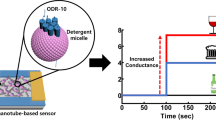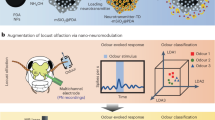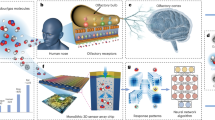Abstract
With the increasing threat of environmental toxicants including biological and chemical warfare agents, fabricating innovative biomimetic systems to detect these harmful agents is critically important. With the broad objective of developing such a biosensor, here we report the construction of a Saccharomyces cerevisiae strain containing the primary components of the mammalian olfactory signaling pathway. In this engineered yeast strain, WIF-1α, olfactory receptor signaling is coupled to green fluorescent protein expression. Using this 'olfactory yeast', we screened for olfactory receptors that could report the presence of the odorant 2,4-dinitrotoluene, an explosive residue mimic. With this approach, we have identified the novel rat olfactory receptor Olfr226, which is closely related to the mouse olfactory receptors Olfr2 and MOR226-1, as a 2,4-dinitrotoluene–responsive receptor.
This is a preview of subscription content, access via your institution
Access options
Subscribe to this journal
Receive 12 print issues and online access
$259.00 per year
only $21.58 per issue
Buy this article
- Purchase on Springer Link
- Instant access to full article PDF
Prices may be subject to local taxes which are calculated during checkout




Similar content being viewed by others
References
Buck, L. & Axel, R. A novel multigene family may encode odorant receptors: a molecular basis for odor recognition. Cell 65, 175–187 (1991).
Mombaerts, P. Seven-transmembrane proteins as odorant and chemosensory receptors. Science 286, 707–711 (1999).
Malnic, B., Hirono, J., Sato, T. & Buck, L.B. Combinatorial receptor codes for odors. Cell 96, 713–723 (1999).
Jones, D.T. & Reed, R.R. Golf: an olfactory neuron specific G protein involved in odorant signal transduction. Science 244, 790–795 (1989).
Bakalyar, H.A. & Reed, R.R. Identification of a specialized adenylyl cyclase that may mediate odorant detection. Science 250, 1403–1406 (1990).
Pace, U., Hanski, E., Salomon, Y. & Lancet, D. Odorant-sensitive adenylate cyclase may mediate olfactory reception. Nature 316, 255–258 (1985).
Mori, K., Nagao, H. & Yoshihara, Y. The olfactory bulb: coding and processing of odor moleculae information. Science 286, 711–715 (1999).
Firestein, S. How the olfactory system makes sense of scents. Nature 413, 211–218 (2001).
Ladds, G., Goddard, A. & Davey, J. Functional analysis of heterologous GPCR signalling pathways in yeast. Trends Biotechnol. 23, 367–373 (2005).
Pausch, M.H. G-protein coupled receptors in Saccharomyces cerevisiae: high throughput screening assays for drug discovery. Trends Biotechnol. 15, 487–494 (1997).
Belluscio, L., Gold, G.H., Nemes, A. & Axel, R. Mice deficient in Golf are anosmic. Neuron 20, 69–81 (1998).
Johnson, G.L. & Dhanasekaran, N. The G-Protein family and their interaction with receptors. Endocr. Rev. 10, 317–331 (1989).
Crowe, M.L., Perry, B.N. & Connerton, I.F. Golf complements a GPA1 null mutation in Saccharomyces cerevisiae and functionally couples to the STE2 pheromone receptor. J. Recept. Signal Transduct. Res. 20, 61–73 (2000).
Liang, J.J., Cockett, M. & Khawaja, X.Z. Immunohistochemical localization of G protein β1, β2, β3, β4, β5, and γ3 subunits in the adult rat brain. J. Neurochem. 71, 345–355 (1998).
Asano, T. et al. Selective localization of G protein γ5 subunit in the subventricular zone of the lateral ventricle and rostral migratory stream of the adult rat brain. J. Neurochem. 79, 1129–1135 (2001).
Russell, M., Bradshaw-Rouse, J., Markwardt, D. & Heideman, W. Changes in gene expression in the Ras/adenylate cyclase system of Saccharomyces cerevisiae: correlation with cAMP levels and growth arrest. Mol. Biol. Cell 4, 757–765 (1993).
Lalli, E. & Sassone-Corsi, P. Signal transduction and gene regulation: the nuclear response to cAMP. J. Biol. Chem. 269, 17359–17362 (1994).
Price, L.A., Kajkowski, E.M., Hadcock, J.R., Ozenberger, B.A. & Pausch, M.H. Functional coupling of a mammalian somatostatin receptor to the yeast pheromone response pathway. Mol. Cell. Biol. 15, 6188–6195 (1995).
King, K., Dohlman, H.G., Thorner, J., Caron, M.G. & Lefkowitz, R.J. Control of yeast mating signal transduction by a mammalian β2 adrenergic receptor and Gs α subunit. Science 250, 121–123 (1990).
Miret, J.J., Rakhilina, L., Silverman, L. & Oehlen, B. Functional expression of heteromeric calcitonin gene-related peptide and adrenomedullin receptors in yeast. J. Biol. Chem. 277, 6881–6887 (2002).
Krautwurst, D., Yau, K.W. & Reed, R.R. Identification of ligands for olfactory receptors by functional expression of a receptor library. Cell 95, 917–926 (1998).
Zhao, H. et al. Functional expression of a mammalian odorant receptor. Science 279, 237–242 (1998).
Araneda, R.C., Peterlin, Z., Zhang, X., Chesler, A. & Firestein, S. A pharmacological profile of the aldehyde receptor repertoire in rat olfactory epithelium. J. Physiol. 555, 743–756 (2004).
Shirokova, E. et al. Identification of specific ligands for orphan olfactory receptors. G protein-dependent agonism and antagonism of odorants. J. Biol. Chem. 280, 11807–11815 (2005).
Minic, J. et al. Functional expression of olfactory receptors in yeast and development of a bioassay for odorant screening. FEBS J. 272, 524–537 (2005).
Kobilka, B.K. et al. Chimeric α2-, β2-adrenergic receptors: delineation of domains involved in effector coupling and ligand binding specificity. Science 240, 1310–1316 (1988).
Kajiya, K. et al. Molecular bases of odor discrimination: reconstitution of olfactory receptors that recognize overlapping sets of odorants. J. Neurosci. 21, 6018–6025 (2001).
Hoffman, C.S. & Winston, F.A. Ten-minute DNA preparation from yeast efficiently releases autonomous plasmids for transformation of Escherichia coli. Gene 57, 267–272 (1987).
Wuestehube, L.J. & Schekman, R.W. Reconstitution of transport from endoplasmic reticulum to Golgi complex using endoplasmic reticulum-enriched membrane fraction from yeast. Methods Enzymol. 219, 124–136 (1992).
Radhika, V., Milkevitch, M., Audige, V., Proikas-Cezanne, T. & Dhanasekaran, N. Engineered Saccharomyces cerevisiae strain BioS-1, for the detection of water-borne toxic metal contaminants. Biotechnol. Bioeng. 90, 29–35 (2005).
Acknowledgements
We would like to thank R. Reed (Johns Hopkins University School of Medicine), N. Gautam (Washington University School of Medicine) and J. Robishaw (Geisinger Clinic) for their kind gift of cDNA inserts encoding rat ACIII, β2 and γ5, respectively. Critical reading of the manuscript by J. Gardner, Z. Goldsmith and R. Saker is gratefully acknowledged. This work was sponsored by the US Defense Advanced Research Projects Agency through the Space and Naval Warfare Systems Center, San Diego, Contract No. N66001-00-C-8050.
Author information
Authors and Affiliations
Contributions
V.R. carried out all the biochemical and fluorometric analyses. T.P.-C. made the receptor cassette and cloned Olfr226. M.J. cloned the receptors from rat olfactory epithelium. D.O. and J.H. assisted in the construction of the WIF-1 strain. D.D. conceived and supervised the project. All authors discussed the results, and D.D. wrote the manuscript.
Corresponding author
Ethics declarations
Competing interests
The authors declare no competing financial interests.
Supplementary information
Supplementary Fig. 1
Amino acid sequences of rat Olfr226, mouse Olfr2 and mouse MOR226-1. (PDF 60 kb)
Rights and permissions
About this article
Cite this article
Radhika, V., Proikas-Cezanne, T., Jayaraman, M. et al. Chemical sensing of DNT by engineered olfactory yeast strain. Nat Chem Biol 3, 325–330 (2007). https://doi.org/10.1038/nchembio882
Received:
Accepted:
Published:
Issue Date:
DOI: https://doi.org/10.1038/nchembio882
This article is cited by
-
A bacterial bioreporter for the detection of 1,3,5-trinitro-1,3,5-triazinane (RDX)
Analytical and Bioanalytical Chemistry (2022)
-
Bacterial bioreporters for the detection of trace explosives: performance enhancement by DNA shuffling and random mutagenesis
Applied Microbiology and Biotechnology (2021)
-
A nitric oxide sensor fabricated through e-jet printing towards use in bioelectronics interfaces
Journal of Applied Electrochemistry (2019)
-
3D Architectured polyazomethine gel synthesis: its self-assembled intercalating complexation with nitro aromatic acceptor
Bulletin of Materials Science (2018)
-
Drosophila melanogaster odorant receptors as volatile compound detectors in forensic science: a proof-of-concept study
Analytical and Bioanalytical Chemistry (2018)



